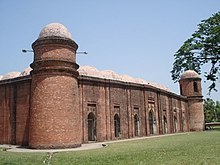Barisal City has one police academy. .== History == Barisal was a semi-independent area in Mughal period because of heavy fighting between them and Hindu chiefs. In course of time, it fell under Bengal Nawabs and British India, later passed to Bangladesh.
Following the partition of India in 1947, the area of Bangladesh became a province of Pakistan, initially known as East Bengal, and then, from 1955, as East Pakistan. The people of East Pakistan Province declared their independence as the nation of Bangladesh on March 26, 1971, while fighting a savage war against the central Pakistani government. The separation from Pakistan took place, with extensive aid from India, on December 16, 1971 as a result of the third Indo-Pakistan War. Bangladesh was soon recognized by most other nations, although Pakistan withheld diplomatic recognition until 1974 and China did not recognize the nation until 1976. Bangladesh was admitted to the United Nations in 1974.
The central city of this region is the city of Barisal. It is one of the biggest river ports in Bangladesh. It is a city with nearly 0.38 million people and a divisional headquarter, medical college, cadet college, some pharmaceutical industries, textile industries and the Bangladesh Inland Water Transport Authority's head office. Barisal is fast growing city of the country stands on the Kirtankhola River. Country's first short landing and take off airport has been completed in Barisal and a private Airlines named Air Bengal has begun its regular air flight between Dhaka Tejgaon Airport and Barisal.
The city is sometimes called the "Venice of the East" or the "Venice of Bengal".
Contents
|
Population
According to an estimate of 2008 Barisal has a population of 210,374;male 53.28%, female 46.72%. Literacy rate among the town people is 85%.Population by Religion
- Muslim 90.64%; Hindu 8.38% and Christian 0.98%.
- Mosque: 130, church: 5
- Temple: More than 200
Educational institutions

Bibir Pukur, Barisal
File:Barisal Divisional HQ.jpg
Divisional Headquarter, Barisal
- University college: 1
- Polytechnic institute: 1
- Medical college: 1
- Physical education college: 1
- Teacher's training college: 2
- Nursing institute: 1
- Cadet college: 1
- Government college: 7
- Non-government college: 7
- Government high school: 2
- Non-government high school: 55
- Junior school: 7
- Government primary school: 175
- Non-government primary school: 133.
- Famous Instituons: Barisal Polytechnic Institutions,Brojomohun College
- Famous Schools: Barisal Govt. Girls High School, Barisal Zilla School,Udayan High School
- Medical College: Sher-E-Bangla Medical college
- Cadet College Barisal Cadet College
- University College: Govt. BM college. (Brojomohun College)
- Mahilara A.N High School. Mahilara,Gournadi,Baisal.8232.
Publications
- Locally published newspapers and periodicals Dailies:
Land
- Cultivable land: 219.03 km²
- Single crop: 36.06%
- Double crop: 46.57%
- treble crop: land 17.37%.
Transport
- Road: 200 km
- Airport: 1
- Port: Internal port
- MV Sundarban 7
- MV Sundarban 8
- MV Surovi 8
- MV Surovi 7
- MV Surovi 6
- MV Dipraj
- MV Parabat 11
- MV Parabat 9
- MV Parabat 7
- MV Kirtonkhola 1
- MV Kalam Khan
Economy
Barisal is a rice producing center of Bangladesh. Balam (a kind of baasmati) is the most popular rice in Barisal. It is also famous for Betel Leaf, a typical south Asian chewing item. As Barisal is surrounded by river so fish is plenty in there.It is said.. "Dhan (paddy) nadi (river) Khal (canal) ai tine Barisal." Means, paddy,river and canal this three thing makes Barisal. Coconut is very common in there as it is a costal area. Hog Plum in Barisal is very famous. Exports: Fish, medicine, bidi (local tobacco) and handicrafts.Noted Barisailese
- Utpal Dutt (29 March 1929 – 19 August 1993), was an Indian actor, director and writer-playwright
- A.K. Fazlul Huq , (Mayor of kolkata (1935, first Muslim mayor of kolkata), Prime Minister of undivided Bengal (1937–1943) and of East Bengal (1954), Home Minister of Pakistan (1955) and Governor of East Pakistan (1956–1958)
- Mohiuddin Jahangir (Bir Shreshto) was a Captain in the Bangladesh Army during the 1971 Liberation War. The main gate of Dhaka Cantonment- "Shaheed Jahangir Gate" is named in his honour.
- Tofazzal Hossain Manik Miah Founder Editor of The Daily Ittefuq.
- Anil Biswas (composer) noted Hindi and bengali film song composer
- Altaf Mahmud noted bengali film song composer and one of the martyred intelligentsia in 1971.
- Jibanananda Das, famous Bengali poet.
- Aroj Ali Matubbar, noted Astronomer and Philosopher.
- Pannalal Ghosh renowned musician and flutist
- Parul Ghosh, Hindi and bengali film singer
- ShantiSudha Bose @ Kanak Dutta freedom fighter and vocal artist
- Utpal Dutta, actor
- Sufia Kamal, poetess
- Amal Kumar Raychaudhuri, physicist
- Abala Bose, social reformer and wife of Jagadish Chandra Bose
- Tapan Raychaudhuri, noted historian.
- Partha Dasgupta, eminent economist.
- Mithun Chakraborty, famous actor.
- Sushmita Sen, famous actress.
- Priya Ranjan Dasmunsi, Minister of parliamentary affairs and information, India.
- Kamini Roy, famous poetess and first woman graduate with honours in the subcontinent .
- Kusumkumari Das, poetess and mother of Jibanananda Das
- Kadambini Ganguly, first female graduate and first female physician in the entire British empire
- Aswini Kumar Dutta, social reformer and philanthropist
- Mosarrof Karim....Actor,Gorunadi,Barisal.>>>Nintu,Mahilara.
- Mr.Ishaque Ali Sarder....Headmaster of Mahilara A.N High school,Gournadi,Barisal(1972 to 2011)
See also
- Barisal District
- Barisal Division
References
- List of cities and towns in Bangladesh, Retrieved December 29, 2009
- "Speech of Mayor on Spacial Intarnational Working Conference". Chittagong City Corporation. http://www.ccc.org.bd/mayors_hague.html. Retrieved 2009-12-21.
- "Area, Population and Literacy Rate by Paurashava –2001". Bangladesh Bureau of Statistics. http://www.bbs.gov.bd/dataindex/census/municip.pdf. Retrieved 2009-09-18.
- "Statistical Pocket Book, 2008" (pdf). Bangladesh Bureau of Statistics. http://www.bbs.gov.bd/dataindex/pby/pk_book_08.pdf. Retrieved 2009-08-15.
- "Area, Population and Literacy Rate by Paurashava –2001". Bangladesh Bureau of Statistics. http://www.bbs.gov.bd/dataindex/census/municip.pdf. Retrieved 2009-08-19.
- Thedailystar.net
- "Statiscal Pocket Book of Bangladesh 2008". Bangladesh Bureau of Statistics. January 2009. http://www.bbs.gov.bd/dataindex/pby/pk_book_08.pdf. Retrieved 2009-08-19.





